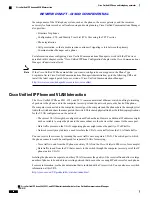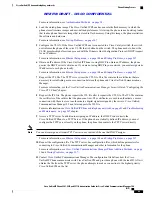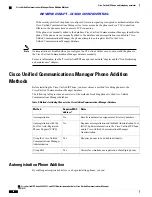
the components of the IP telephony system, such as the phones, the access gateways, and the resources
necessary for features such as call conferencing and route planning. Cisco Unified Communications Manager
also provides:
•
Firmware for phones
•
Configuration, CTL, and Identity Trust List (ITL) files using the TFTP service
•
Phone registration
•
Call preservation, so that a media session continues if signaling is lost between the primary
Communications Manager and a phone
For information about configuring Cisco Unified Communications Manager to work with the IP devices
described in this chapter, see the
“
Cisco Unified IP Phone Configuration
”
chapter in the
Cisco Communications
Manager Administration Guide
.
If the Cisco Unified IP Phone model that you want to configure does not appear in the Phone Type
drop-down list in Cisco Unified Communications Manager Administration, go to the following URL and
install the latest support patch for your version of Cisco Unified Communications Manager:
http://www.cisco.com/kobayashi/sw-center/sw-voice.shtml
Note
Cisco Unified IP Phone and VLAN Interaction
The Cisco Unified IP Phone 8961, 9951, and 9971 contains an internal Ethernet switch, enabling forwarding
of packets to the phone, and to the computer (access) port and the network port on the back of the phone.
If a computer is connected to the computer (access) port, the computer and the phone share the same physical
link to the switch and share the same port on the switch. This shared physical link has the following implications
for the VLAN configuration on the network:
•
The current VLANs might be configured on an IP subnet basis. However, additional IP addresses might
not be available to assign the phone to the same subnet as other devices that connect to the same port.
•
Data traffic present on the VLAN supporting phones might reduce the quality of VoIP traffic.
•
Network security may indicate a need to isolate the VLAN voice traffic from the VLAN data traffic.
You can resolve these issues by isolating the voice traffic onto a separate VLAN. The switch port to which
the phone connects would be configured for separate VLANs for carrying:
•
Voice traffic to and from the IP phone (auxiliary VLAN on the Cisco Catalyst 6000 series, for example)
•
Data traffic to and from the PC that connects to the switch through the computer (access) port of the IP
phone (native VLAN)
Isolating the phones on a separate, auxiliary VLAN increases the quality of the voice traffic and allows a large
number of phones to be added to an existing network that does not have enough IP addresses for each phone.
For more information, see the documentation that is included with a Cisco switch. You can also access switch
information at this URL:
http://cisco.com/en/US/products/hw/switches/index.html
Cisco Unified IP Phone 8961, 9951, and 9971 Administration Guide for Cisco Unified Communications Manager
10.0 (SIP)
42
Cisco Unified IP Phone and telephony networks
Cisco Unified IP Phone and VLAN Interaction
REVIEW DRAFT - CISCO CONFIDENTIAL
















































